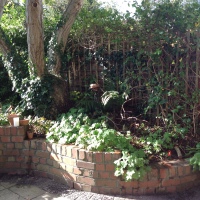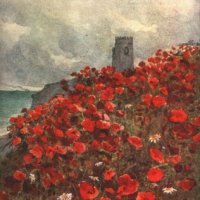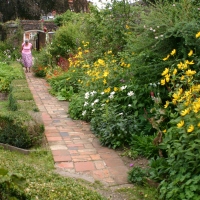 This year marks the bicentenary of the birth of Sir Joseph Dalton Hooker, renowned plant hunter, naturalist, botanist and Director of the Royal Botanic Gardens at Kew. On a recent visit to his home town of Halesworth, Suffolk, I discovered a modern day band of enthusiastic gardeners who are planning a big celebration of their famous ancestor.
This year marks the bicentenary of the birth of Sir Joseph Dalton Hooker, renowned plant hunter, naturalist, botanist and Director of the Royal Botanic Gardens at Kew. On a recent visit to his home town of Halesworth, Suffolk, I discovered a modern day band of enthusiastic gardeners who are planning a big celebration of their famous ancestor.

Joseph Dalton Hooker as a young man
You may know that one of my voluntary activities is as a judge for the Green Flag Award- the bench mark for good public parks and gardens around the U.K. and beyond. I was honoured to be asked to visit Halesworth Town park recently a small public park in the centre of this old Suffolk Market town, jointly in the care of the local Council and ‘Halesworth in Bloom’, a group of volunteers who have spearheaded many improvements and projects to make the park and wider town a place of horticultural excellence.
During my visit i was shown round the Park and had the chance to learn more about the voluntary effort being put into this very impressive public park, and was also very pleased to see the energy and skills being put into marking Joseph Hooker’s bicentenary; this includes some special plantings in the Park with Hooker associations and a trail around the town and park featuring places, plants and other Hooker associations. The following text is unashamedly lifted from very informative Trail Leaflet produced and which will be launched in the town on 30th June, Hooker’s birthday.

Nepenthes x hookerianum- illustration by Anna Lu to be shown at the forthcoming botanical art exhibition in Halesworth
‘Joseph started attending his father’s botany lectures at Glasgow University at the age of seven! This stood him in good stead when he came to identify and record thousands of both new and known plants. To go on his first voyage of exploration circumnavigating the Antarctic he had to qualify as a medical doctor. He was also an accomplished amateur geologist, a geographer, meteorologist and cartographer, as well as a botanist. He was a skilled writer, artist and botanical illustrator, recording everything in his fascinating journals. He was able to measure and record air pressure, humidity and altitude, and to estimate the heights of mountains so accurately that his mapping of the Himalayas is the basis for all modern maps of the area.

An illustration from Hooker’s ‘Botany of the Antarctic Voyage’
He travelled on foot, sometimes barefoot when it was slippery. In India and Sikkim he travelled by elephant, pony and boat. He endured many biting insects and leeches, and braved man-eating tigers and crocodiles, as well as suffering altitude sickness. As is evident from his Himalayan Journals, he needed to be an intrepid walker and climber.
‘I staid at 13000ft very much on purpose to collect there seeds of the Rhododendrons & with cold fingers it was not very easy…. Botanizing, during the march is difficult. Sometimes the jungle is so dense that you have enough to do to keep hat & spectacles in company, or it is precipitous …. one often progresses spread- eagle fashion against the cliff, for some distance, & crosses narrow planks over profound Abysses, with no hand-hold whatever.’
His collection of thousands of plants, now carefully preserved at Kew, together with his studies of plant distribution linked to altitude, climate and isolation on the many islands he visited, was of significant importance to Darwin, with whom he corresponded regularly.

Rhododendron argenteum
Joseph Hooker, although he was eight years younger, was a close friend of Charles Darwin. They had met fleetingly when Hooker was 21 and was preparing for a long expedition on HMS Erebus as assistant surgeon. When Hooker returned in 1843, Darwin wrote welcoming him back, urging him to compare the flora of the different regions he had visited. Hooker drafted a paper showing the striking similarities in the plants across the whole of the Southern Hemisphere. This was a long time before continental drift had been mooted. Darwin was impressed. So began a close friendship, with Hooker helping Darwin with his botanical collection. As Hooker was preparing for his expedition to the Himalayas in 1847, Darwin wrote:
‘Farewell! What a good thing is community of tastes! I feel as if I had known you for fifty years….’
Hooker knew that Darwin had spent many years collecting material in support of his theory of natural selection, and that Darwin had been devastated when he received a letter from Alfred Russel Wallace in 1858 coming up with the same idea. Hooker and Thomas Henry Huxley persuaded Darwin to publish a paper alongside Wallace’s setting out the theory. That done, Darwin rapidly finished On the Origin of Species, which he had been preparing for so many years. It was printed the following year. Their friendship ranged from science to domestic matters. In 1862 Hooker wrote to Darwin asking if his wife could recommend a good cook but she must be beyond the ‘the age of flirtation’. Darwin noted what a pity it was that natural selection had not produced ‘neuters’ who would neither flirt nor marry. After Darwin’s death in 1882, Hooker successfully lobbied for Darwin to be buried in Westminster Abbey and was one of the pall bearers at the funeral.

Joseph Dalton Hooker in later years
William and Joseph Hooker (father and son) were Directors of the Royal Botanic Gardens at Kew – William from 1840 to 1865 and Joseph from 1865 to 1885, nearly half a century between them. They were both keen plant collectors and highly accomplished artists. From 1806 to 1820 the family lived in Halesworth, where Joseph was born in 1817.
Sir William Jackson Hooker was originally from Norwich and came to Halesworth in 1806 when he had invested in a Halesworth brewing business. He was given a house here and a management position. There are still imposing maltings in the town such as those that now house The Cut and Kings Motors. The Cut Arts Centre retains the barley hopper in the Malt Room Art Gallery. William’s maltings remained in operation until the 1960s. However, he never had his heart in this enterprise and preferred to roam the countryside in search of wild flowers or, nearer to home, to cultivate orchids in his own hot-house. It was the age of the amateur naturalist and collector, and William and later his son Joseph were among the greatest in this country.
 Sir William was able to become Professor of Botany in the University of Glasgow without any scientific qualifications because of his specialist knowledge picked up in the field and his published work.
Sir William was able to become Professor of Botany in the University of Glasgow without any scientific qualifications because of his specialist knowledge picked up in the field and his published work.
At the University he was paid to give lectures to those studying medicine because most remedies were plant based. He built up a high reputation, producing many important illustrated reference books. As a result he was made the first Director of the Botanic Gardens at Kew. As Director, William increased the size of the Gardens to 300 acres and set up a library, a Museum of Economic Botany and a herbarium, as well as the remarkable Palm and Temperate Houses.

The Palm House, Kew
He used his links with the royal family to good effect and raised significant funding to develop the Botanic Gardens at Kew. Both he and Joseph were outstanding networkers who knew everyone important and used these contacts effectively to leverage what they wanted in the interests of botany and the Botanic Gardens. They also encouraged many other important plant collectors and William, with wealthy patronage, established a superb Arboretum. William’s only regret was probably not being able to travel more. His early expedition to Iceland was his only major scientific journey. He encouraged his son, Joseph Dalton Hooker, who went as assistant surgeon and botanist on a four-year expedition circumnavigating the South Pole and visiting New Zealand and Tasmania. To be accepted for the voyage Joseph had to get a medical degree.
 Later, he collected in India, the Himalayas of Nepal and Tibet, Morocco, the Atlas Mountains, Palestine and Syria, as well as undertaking an 8,000 mile journey across the USA. In the Himalayas he climbed Donkia mountain, which at 19,300 ft was the highest that anyone had ever reached at that time. On his travels he collected 25 new species of rhododendron, many magnolias, including Magnolia campbellii, and thousands of other specimens.
Later, he collected in India, the Himalayas of Nepal and Tibet, Morocco, the Atlas Mountains, Palestine and Syria, as well as undertaking an 8,000 mile journey across the USA. In the Himalayas he climbed Donkia mountain, which at 19,300 ft was the highest that anyone had ever reached at that time. On his travels he collected 25 new species of rhododendron, many magnolias, including Magnolia campbellii, and thousands of other specimens.

Rhododendrons at Heligan, Cornwall, grown from seed provided from Hooker’s travels
Joseph’s 150-year-old plant collection is currently helping in the reintroduction of original species to the Falkland Islands. The Hookers’ collections (Herbaria) consist of many thousands of plants at Kew and are highly prized.
As well as succeeding his father as Director of Kew Gardens, Sir Joseph Dalton Hooker was awarded the Order of Merit, Knight Grand Commander of the Order of the Star of India, Companion of the Order of the Bath and the Presidency of the Royal Society. In 1858 George Bentham published his Handbook of the British Flora while working with Hooker at Kew. When Bentham died he left the Flora to Hooker, who edited the later editions. These, known as ‘Bentham and Hooker’, were used by university students for the next hundred years.’
2011 stamp issue to mark the 100th anniversary of Hooker’s death
Plants in Halesworth associated with Hooker:
-
Allium hookeri – small white allium
-
Crinodendron hookerianum – Chile lantern tree, evergreen climbing shrub
-
Deutzia hookeriana – scented shrub with white and pink flowers
-
Himalayacalamus hookerianus – blue bamboo
-
Inula hookeri – yellow daisy-like perennial
-
Iris hookeri – small blue iris
-
Polygonatum hookeri – creeping alpine with pink flowers
-
Rhododendrons (Sikkim) – Hooker was influential in starting the Victorians’ rhododendron mania by bringing back over 25 species
-
Salix hookeri – dune willow
-
Sarcococca hookeriana – sweet scented winter box
If you’re able to visit Halesworth on 30th June you are in for a horticultural treat as the Hooker Trail is launched. There’s also going to be a special exhibition of botanical art (from 1st July). For that matter, I’d recommend visiting the town at any time as it’s a wonderful example of local people playing a hands on role in creating a vibrant and beautiful community.

Hooker’s grave in the churchyard of St. Anne’s, Kew
Further information:
Halesworth Exhibition of Botanical Art
The Hooker bicentenery in Halesworth
Halesworth in Bloom- the Hooker Trail
Old School Gardener







